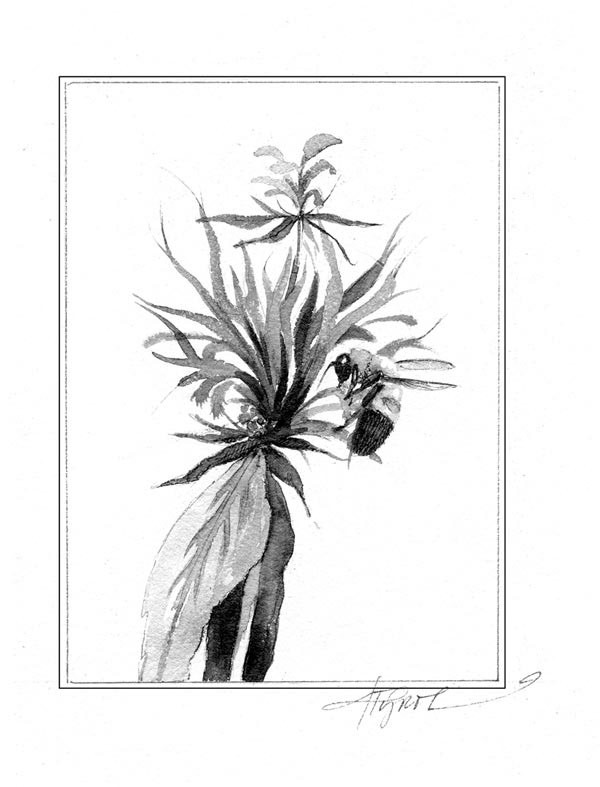
There has been a lot of bad buzz about bee populations lately, mostly about the decline of European honeybees that are used across North America to help pollinate everything from California almonds to Maine blueberries. Scientists coined the phenomenon colony collapse disorder (CCD), and have since identified a variety of culprits, including pathogens, toxins, and stressful apicultural practices.
But while CCD focused scientists and the public on the threat to honeybees, a non-native species originally imported from Europe in the 17th century, some native bees appear to be in serious trouble, too. These natives are often highly specialized and efficient foragers that are important pollinators for tomatoes, cucumber, squash, berries, and fruit orchards. Across the United States, these native pollinators annually contribute an estimated $3 billion worth of crop pollination.
In the late 1990’s, bee biologists started to notice a decline in the abundance and distribution of several bumblebee species, and in the Northeast, there appeared to be a sudden, range-wide decline in numbers. Leif Richardson, a biologist with the Vermont Fish and Wildlife Department, was concerned.
Because there was no data on bumblebee populations in the region, Richardson visited the insect collections at the University of Vermont and other institutions to examine past records of bumblebee abundance. Richardson found that students had commonly collected one species, the rusty-patched bumblebee, in the 1960s and 1970s but that, despite searching for them, no rusty-patched specimen has been found in Vermont in recent years. What was among the most common bumblebee species of fields, farms, and gardens is just about completely gone.
Because the rusty-patched bumblebee disappeared, so did the Ashton cuckoo bumblebee. Cuckoo bumblebees are antisocial bees that parasitize other bumblebee colonies. They infiltrate a rival queen’s colony, enslave the workers, and use them to feed the cuckoo’s young. The Ashton cuckoo specializes in parasitizing the nests of rusty-patched bumblebees. As the host disappears, so goes the parasite.
Bumblebees are excellent pollinators of greenhouse-grown tomatoes and other plants, and this may be where some of the trouble began. In order to increase crop production, especially in greenhouse-grown tomatoes that don’t benefit from wind for natural pollination, farmers release common Eastern bumblebees into their greenhouses. As it happens in these days of global trade, many of these native American bees are actually hatched and raised in Europe before being exported back home. While in Europe, some of the queens were infected by intestinal parasites common to native European bumblebees, and those parasites came to North America on the homeward journey.
Some of the imported and infected bumblebees escaped from the greenhouses where they were working and came into contact with wild bumblebees populations, transmitting the parasites to them. In 2006, Sheila Colla, a doctoral student at York University in Toronto, and colleagues captured native bumblebees at varying distance from commercial greenhouses where bumblebees were being used. They found that native bees captured close to these greenhouses were much more likely to be infected with introduced parasites than those captured far away.
The common Eastern bumblebee is a host that isn’t affected by these parasites. It can, however, carry them and pass them onto other bumblebees. Short-tongued bumblebees, such as rusty-patched and yellow-banded bumblebees, appear to be especially sensitive to these introduced parasites, and this may explain the decline in wild populations.
Introduced parasites are not the only problem facing our native bumblebees. Habitat loss and land fragmentation, planting of monocultures, and urbanization are taking their toll on pollinator populations of all kinds. Some widely used pesticides, particularly the neonicotinoids, may be as big a threat to bumblebees as they are to honeybees in colony collapse disorder.
The Xerces Society, one of the leading insect conservation groups in North America, has placed the rusty-patched bumblebee, the yellow-banded bumblebee, and two western species, the western bumblebee and Franklin’s bumblebee, on its red list of most-threatened insects. Franklin’s, confined to just southern Oregon and northern California, has not been found since 2004 and might be extinct. The rusty-patched bumblebee might not be far behind.
Though there is some hope. In Vermont last year, Richardson found a rise in yellow-banded bumblebee populations, and this year, the bees appear to buzzing around again. No one knows why they might be recovering, but at least the trend is good.


Discussion *